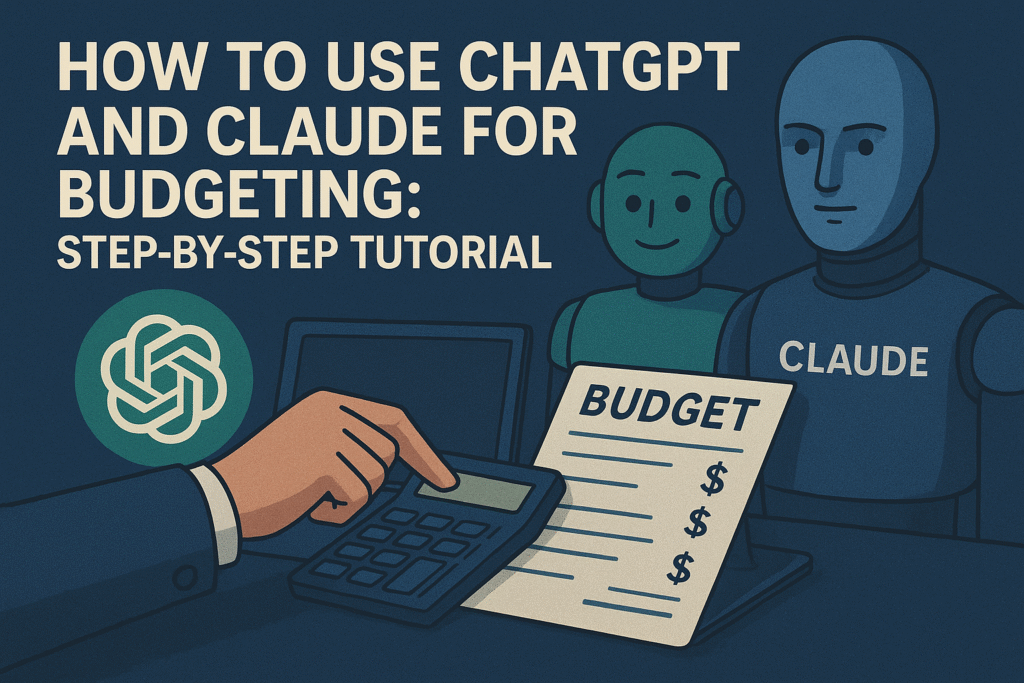
Want to take control of your money with artificial intelligence? In 2025, AI chatbots like ChatGPT (by OpenAI) and Claude (by Anthropic) have become powerful, user-friendly tools for personal budgeting, expense tracking, and financial planning. This SEO-focused tutorial walks you through using ChatGPT and Claude for smarter budgeting—designed for US and global readers.
Table of Contents
- Why Use AI Chatbots for Your Budget in 2025?
- Getting Started: What You Need
- Step 1: Gather Your Financial Info
- Step 2: Starting Conversations—ChatGPT vs. Claude
- Step 3: Automated Expense Categorization With AI
- Step 4: Creating and Tracking a Custom Budget
- Step 5: Getting Personalized Savings and Spending Advice
- Frequently Asked Questions
- Conclusion: Smarter Budgeting for US and Global Users
Why Use AI Chatbots for Your Budget in 2025?
- Instant insights: Get clear, jargon-free answers to budget questions—no finance degree required
- Automated categorization: Copy-paste transactions for lightning-fast expense sorting
- Personalized advice: Get realistic, actionable savings goals and cost-cutting tips in seconds
- Privacy: No need to link your bank (unless you want to)—use AI as a “virtual coach”
- Works everywhere: Web, mobile, desktop, and across US/global currencies and personal finance systems
SEO note: “ChatGPT budgeting US 2025”, “best AI for budgeting worldwide”, “how to use Claude for personal finance” are great secondary keywords!
Getting Started: What You Need
- Free or paid access to ChatGPT and/or Claude (sign up with your email)
- A list of your recent transactions (download from your online bank or credit card, or copy from an app)
- Your monthly income amount and fixed/recurring expenses
- A list of savings goals (emergency fund, down payment, travel, etc.)
Step 1: Gather Your Financial Info
Collect and organize:
- Recent transactions (1–2 months)—from your bank/app
- Regular monthly bills (rent, mortgage, utilities, subscriptions)
- Variable costs (groceries, entertainment, dining out)
- Your take-home income for a typical month
This makes the AI’s analysis accurate and actionable.
Step 2: Starting Conversations—ChatGPT vs. Claude
Both ChatGPT and Claude work as chatbots—you type instructions, questions, or data; they reply with insights, suggestions, or breakdowns.
- ChatGPT is excellent for:
- Budget summaries
- “What if” scenarios (ex: What happens if I cut dining out by 20%?)
- Categorizing spending with advanced logic
- Claude excels at:
- Analyzing long text or large data sets (paste 100+ transactions easily!)
- Giving deeply explained “why” behind tips or warnings
How to Start
Paste your data or start with a prompt, for example:
“Act as a personal budget advisor. Here’s my income and expenses for July. Help me categorize, analyze overspending, and suggest ways to save more next month.”
Step 3: Automated Expense Categorization With AI
Copy a list of transactions (ex:07/01 Starbucks $8.23, 07/01 Aldi $53.45, 07/02 Lyft $14.00...)
Prompt example for ChatGPT or Claude:
“Categorize these transactions for my budget. Group them by main category (food, transport, bills, etc) and give a total for each.”
Pro Tip: For big lists, use Claude—it can process more data per message.
SEO keyword: “AI categorize expenses,” “ChatGPT for expense tracking”
Step 4: Creating and Tracking a Custom Budget
Ask the AI to create a budget template, or have it analyze your amounts:
“Based on my July income and these categorized expenses, create a simple budget for August. Show me how much I have left for discretionary spending.”
Want week-to-week guidance?
“Set up a weekly budget plan based on my monthly numbers and recurring bills.”
Step 5: Getting Personalized Savings and Spending Advice
Ask:
- “What categories am I overspending on versus the 50/30/20 rule?”
- “Suggest 3 practical ways for me to save $100 more each month given my data.”
- “How much should I allocate to emergency savings vs. retirement if I want to buy a house in three years?”
The AI will give tailored tips—based on your real patterns and stated goals.
Frequently Asked Questions
Q: Is it safe to share financial data with ChatGPT/Claude?
A: Never paste full account numbers, SSN, or highly sensitive data. For privacy, share only transaction details and keep real names out. Both OpenAI and Anthropic have strict privacy rules, but treat public/consumer AI like a coach, not your accountant.
Q: Can these AIs remember my data between sessions?
A: No, unless you subscribe to advanced paid features with “memory”—assume each chat is separate.
Q: Will ChatGPT or Claude sync with my bank?
A: Not directly—they’re for advice and spreadsheet-like calculations, not for direct automation (yet).
Conclusion: Smarter Budgeting for US and Global Users
ChatGPT and Claude turn budgeting from a headache into a conversation.
- You get personalized, actionable insights in seconds.
- Privacy is in your hands—you provide only the data you want.
- The approach works for the US and worldwide, dollars, pounds, euros, or rupees.
Ready to start?
- Gather your transactions
- Launch ChatGPT or Claude
- Try the prompts above—or invent your own!
For more step-by-step guides, real-world examples, and expert tips, explore our other AI finance tutorials—and subscribe to get the latest on mastering your money with AI!